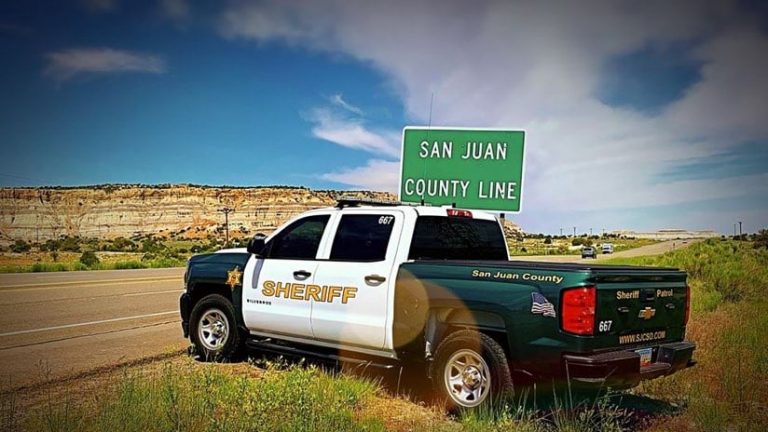

February 21, 2019 |
February 26, 2020

Every weekend, the population of Farmington, New Mexico, explodes. As the largest city in the mostly rural Four Corners region, it draws people to shops, restaurants, movie theaters, and bars. Crowds cause a new set of challenges for law enforcement who see a dramatic shift from answering service calls for a city of 120,000 people during the week to more than double that on the weekends.
Calls to keep the peace can stretch into the early hours when those who come to party make bad choices. Arrests often result in open warrants, because defendants flee or fail to show up for court. The nearby Navajo Reservation, where local police have no jurisdiction, complicates matters because authorities say it can serve as a lure to fugitives. Until recently, the backlog of warrants kept growing.
“It was hard for deputies to search and see open warrants,” said Eli Lisko, information systems manager for the San Juan County Sheriff’s Office and a reserve sheriff’s deputy. “Deputies were typically going after warrants they obtained themselves as part of an investigation or looking for specific people from recent high-profile cases. They didn’t have the ability to effectively target older warrants or see where they needed to do house checks.”
Now, deputies can use an app, powered by the county’s geographic information system (GIS), to see all active warrants near their location. The app reveals a drop-down list of crimes for people with open warrants, and when a deputy chooses a warrant to follow up on, the app routes them to last known addresses.
“Apps have to be practical, easy, and straight to the point for our deputies to even want to use them,” said Sherice Snell, GIS manager for San Juan County. “We’ve had good success with this app because it makes the job much easier.”
Tracking Down Fugitives
When there are no active service calls, patrol officers can use the app to go after the thousands of active warrants in San Juan County.
“This provides deputies with another opportunity to be proactive in the community instead of just finding busy work,” Lisko said.

The job of finding people with active warrants comes with many challenges, including the knowledge that many will fight to stay out of jail. The severity of a warrant dictates the strategy, and different times of year pose opportunities.
“If it’s Thanksgiving or Christmas and it’s a misdemeanor warrant, it’s unlikely we’re going to hunt that person down and take them away from their family,” Lisko said. “However, if it’s a violent felony warrant, you can be assured we’re checking houses.”
For the San Juan County Sheriff’s Office, tactics are built on past successes.
“You have to think like a criminal to figure out where they’re at and how to arrest them,” Lisko said. “I was on patrol with a fellow deputy, and we pulled up the app to search our area. We found a felon who had four felony warrants for his arrest, some violent felony charges, and three known addresses. We started checking those addresses and found him at the third address, sitting in a convertible car with a tarp over it. The app helped us locate him, and although he did try to run and fight us, we were able to safely take him into custody without anyone getting hurt.”
Another incident Lisko recalled reveals the delicate nature of approaching a suspect’s front door. Often people with active warrants know that if they don’t answer the door or give a reason to come in, then deputies can’t enter.
“We went to the last known address for one suspect on a Friday night, and her ex-husband’s family told us exactly where to find her,” Lisko said. “When we got to her apartment, instead of doing the cop knock, we did the boyfriend knock, a gentle tap, tap, tap. She comes to the door all excited to see her date and then is completely sad and disappointed when she sees the two deputies standing at the door.”
Keeping a Positive Reputation
Before they started using the app, deputies often made multiple visits to old addresses.
“Deputies had no effective way to log or share if a residence had changed to a different tenant,” Lisko said. “They’d knock on a door, and the person answering would become so frustrated, saying ‘You keep coming here, and I keep telling you that I don’t know this person.'”
The new app solves that issue, allowing a deputy to quickly flag and share a bad address with fellow deputies. This move supports the San Juan County Sheriff’s Office in its mission to do good work and be compassionate. The team’s philosophy is to partner with the community and be fair in upholding the law.
“I’ve been out working traffic control at a crime scene, and people will yell ‘thank you’ out their car window as they drive past,” Lisko said. “Those aren’t the words a cop is used to hearing. It shows the rapport we’ve built with our community.”

The next app project under development is one that will help with crisis intervention—specifically for people with mental illness.
“We’ve gathered a database of people with mental health issues who submit information in anticipation of a crisis event. This data details the name of their doctor, the medicines they take, what gets them angry, and how to calm them down,” Lisko said. “We’re working to put that detail on a secure map so that deputies can see if the address they’re responding to is the known residence of someone with mental illness. The data can mean the difference of a person calmly getting into our squad car to make a trip to the hospital versus having to fight them, and taser them, and take them to jail, or worse.”
Lisko said the officers hope to repeat the success they had in deploying and using the warrant app.
“This is one of the few pieces of software I’ve released in my career that has been openly embraced with minimal to no complaints,” Lisko said. “And it helps keep wanted people off the streets.”
Learn more about how GIS improves public safety.

February 21, 2019 |

August 28, 2019 |

November 1, 2018 |